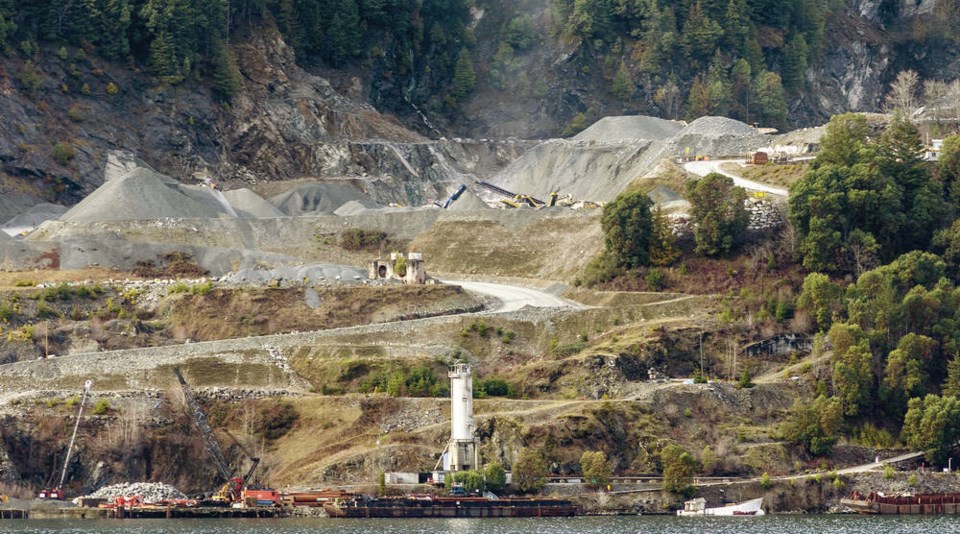The expansion of the Bamberton aggregate quarry in Mill Bay will not undergo an environmental review.
Late Tuesday afternoon, Environment Minister George Heyman released his decision that the quarry expansion planned by the Malahat First Nation will instead undergo an enhanced review through the Mines Act permit process.
The enhanced review permit process will include ongoing consultation with the Environmental Assessment Office, technical review by geotechnical, geoscience and reclamation specialists, and further engagement with First Nations and the public.
In a statement, Heyman noted concerns raised about risks to the sensitive and unique Saanich Inlet ecosystem will be addressed by the enhanced permit amendment review process, coupled with the cumulative effects analysis to be developed in consultation with First Nations and the Environmental Assessment Office.
The decision was slammed by Green Party MLA Adam Olsen who along with the Saanich Inlet Protection Society has been pushing for an environmental review for months.
“I’m really frustrated by this,” said Olsen, minutes after the decision was released. “The minister has made a decision that virtually renders the First Nations who participate in this process invisible. They’ve made the decision that basically the inherent rights, the treaty rights of First Nations on the Saanich Inlet are going to be viewed as in parallel to the decision about whether or not to grind this mountain down.
“That’s completely inappropriate and goes against everything that this government claims and promises to be.”
The Tsartlip First Nation had been pushing for the environmental assessment, and complained it had not been consulted about the proposed expansion. Olsen, a Tsartlip member, said without an environmental assessment, the quarry can continue through the same approval process everybody was unsatisfied with from the very beginning.
“I had little confidence in this process. I have absolutely no confidence in this process now,” Olsen said. “They’ve just declined to engage the environmental process and now they’ve created some fancy rhetoric. Until they put meaning to it is meaningless.”
Maureen Alexander, a member of the Saanich Inlet Protection Society, said she was disappointed in the decision. She said government ministries are still missing the point. “The point of our environmental assessment campaign was not to stop the quarry, it was to protect Saanich Inlet. Mines doesn’t protect the inlet, that’s not their jurisdiction at all. They may do wondrous things for the quarry, but as soon as the dust leaves the site or runs off into the water, they could care less,” she said. “We weren’t trying to take the financial opportunities away from the Malahat or anything like that.”
The Saanich Inlet Protection Society had been pushing for an environmental review of expansion plans for the Bamberton aggregate quarry citing the potential impact of the Malahat Nation’s plans to increase the size and production of the existing quarry, extend its dock on the Saanich Inlet and expand a soil deposit site.
The society said it had scientific information that suggests a danger of contamination if the quarry is expanded.
Heyman did recommend that if the Energy, Mines and Low Carbon Innovation Ministry does approve the quarry expansion, annual reporting on environmental monitoring should be required, with review by an environmental review committee to ensure any mitigation measures imposed are effective.
The Environmental Assessment Office already determined that the renewal of a foreshore lease for a dock and a permit for a clean fill site on the property were not eligible for an environmental assessment because both have been in operation for years.
Josh Handysides, chief administrative officer for the Malahat First Nation, said the government has found a path forward in a difficult situation.
“It allows Malahat to move ahead while still recognizing more work needs to be done on the future of Saanich Inlet,” he said, noting the two are not mutually exclusive. “There is a path for things to go forward and to still find ways to better protect the environment.”
Handysides said it’s a balanced decision as the government has signalled it will look at some of the bigger issues raised during the process about the state of the Inlet.
“It addresses everyone’s concerns while still allowing the Nation to continue on the mine permit process,” he said. He also said the process of mending fences with Mill Bay neighbours and neighbouring First Nations has already stared and the new Malahat council has signalled its intent to grow the relationships with the surrounding communities.
>>> To comment on this article, write a letter to the editor: [email protected]



